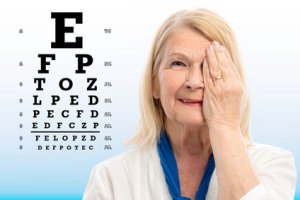High-dosed supplementation for the eye disease, AMD
- and some good dietary advice
 AMD (Age-related Macular Degeneration) is a common eye disease that impairs your reading vision in particular. High-dosed supplementation with vitamin C, vitamin E, zinc and other antioxidants has been shown to help. The recommendation of these nutrients is based on documentation from a large American research project and demonstrate that normal recommendations (DRI = Daily Reference Intake) are inadequate as treatment for various disorders. There are also different foods that are highly relevant for preventing AMD or as part of a treatment against the condition.
AMD (Age-related Macular Degeneration) is a common eye disease that impairs your reading vision in particular. High-dosed supplementation with vitamin C, vitamin E, zinc and other antioxidants has been shown to help. The recommendation of these nutrients is based on documentation from a large American research project and demonstrate that normal recommendations (DRI = Daily Reference Intake) are inadequate as treatment for various disorders. There are also different foods that are highly relevant for preventing AMD or as part of a treatment against the condition.
AMD is a disease in the macula (yellow spot) that blurs your sharp, central vision, which you need to see fine details. AMD can occur as dry AMD (the most common form) or progress into another form called wet AMD. Dry AMD causes loss of the sensory cells of the yellow spot. The first signs are that straight lines begin to look distorted to you. Your central vision eventually becomes increasingly blurry and colorless, which prevents you from reading or recognizing faces. Your vision may eventually become that impaired, you may no longer drive a car. Needless to say, daily tasks become increasingly challenging to handle.
AMD takes several years to develop and is more common among older people. 12% of people older than 60 years have AMD symptoms, while many others have the disease without knowing about it. Ageing processes, unhealthy diets, overweight, and type-2 diabetes may predispose to the disease. Therefore, we are able to do a lot in terms of prevention through diet, weight management, and lifestyle in general.
Free radicals and oxidative stress play a role in the development of AMD
Oxidative stress (an imbalance between free radicals and antioxidants) plays a superior role in the loss of sensory cells in the macula. Free radicals are aggressive molecules that attack cells. The free radical burden increases as we grow older and as a result of factors like smoking, overweight, type-2 diabetes, stress, poisoning, inflammation, and ionizing radiation. Our only protection against free radicals is the presence of different antioxidants like vitamins C and E, beta-carotene (a precursor of vitamin A), zinc, selenium, and various plant compounds with antioxidant properties.
What antioxidants have in common is their ability to neutralize free radicals by donating a single electron. Some antioxidants even initiate molecular repair mechanisms. However, if the antioxidants present in the body are outnumbered by the free radicals, it creates a condition called oxidative stress, which can lead to tissue damage in the body and set the stage for different types of disease, including disease in the yellow spot (macula) of the retina, which controls detailed vision. In other words, preexisting AMD may develop faster if the body lacks antioxidants.
Antioxidants in high quantities may delay the development of AMD
AMD is incurable. Still, one may be able to delay the disease. In a large American, placebo-controlled study from 2001 (AREDS), scientists gave large doses of vitamin C and E, beta-carotene, zinc, and copper (see box below) to patients with moderate AMD. The study showed that these high-dosed supplements lowered the risk of developing advanced AMD by 25 percent. Moreover, the risk of the disease progressing into wet AMD was reduced by 38 percent.
Beta-carotene is found naturally in carrots and other vegetables, but according to two widely discussed studies (the ATCB study and the CARET study), beta-carotene may increase the risk of cancer in smokers. There are alternatives to beta-carotene, however. A 2012 study (called AREDS 2) has demonstrated that supplementation with two related antioxidants called lutein and zeaxanthin have every bit as good a preventive effect as beta-carotene.
Lutein and zeaxanthin occur naturally in the retina of the eye and in the yellow spot. Lutein and zeaxanthin are also found in different foods, mainly in egg yolks.
| Supplements used with AMD | RI (reference intake) level | AREDS (2001) | AREDS 2 (2012) |
| Vitamin C | 80 mg | 500 mg | 500 mg |
| Vitamin E | 12 mg (= 8 IU) | 266 mg (=400 IU) | 266 mg (=400 IU) |
| Beta-carotene precursor of pure vitamin A (retinol) |
800 micrograms RE = 9.6 mg beta-carotene The total vitamin A activity is measured in retinol equivalents (RE). 1 RE = 1 microgram of retinol = 12 micrograms of beta-carotene |
15 mg | 0 |
| Zinz | 10 mg | 80 mg | 25 mg (zinc oxide) |
| Copper | 1,000 mg | 2 mg | 2 mg (copper oxide) |
| Omega-3 fatty acids | No RI |
1 gram |
|
| Lutein | No RI | 10 mg | |
| Zeaxanthin | No RI | 2 mg | |
|
As shown in the table, the recommended dosages for AMD are up to 50 times higher than RI intake levels |
|||
Why the eyes need beta-carotene, lutein, and zeaxanthinBeta-carotene, lutein, and zeaxanthin belong to a group of nutrients called carotenoids that are synthesized by plats such as carrots, leafy, dark greens, and blueberries. The human body converts beta-carotene into pure retinol (vitamin A) that is important for the retina and for light perception. Lutein and zeaxanthin are found in the retina and in the macula where they function as antioxidants and protect the eyes against the harmful effect of strong blue and ultraviolet light. Lutein and zeaxanthin are also found in egg yolks. |
Early prevention of AMD
To prevent AMD, make sure to eat a healthy diet so you get plenty of the different antioxidants on a daily basis. Eggs, spinach, leafy greens, broccoli, and blueberries are excellent sources of lutein and zeaxanthin. You can take extra vitamin C and a strong multivitamin that contains minerals like zinc and selenium in organic forms that are easily absorbed and utilized. Also, quit smoking, keep your blood sugar stable, maintain normal body weight and waist circumference and try to avoid stress to limit the number of free radicals in your body.
Your daily egg – a health advantageStudies show that eggs help prevent AMD, which is because they contain the antioxidants, lutein and zeaxanthin. |
References
Fødevarestyrelsen
Age-Related Eye Disease Study Research Group. A randomized, placebo-controlled, clinical trial of high-dose supplementation with vitamin C an E, beta carotene, and zinc for age-related macular degeneration and vision loss. AREDS report no. 8. PubMed 2001
https://www.ncbi.nlm.nih.gov/pubmed/11594942
AREDS2 Research Group. The Age-Related Eye Disease Study 2 (AREDS2): study design and baseline characteristics (AREDS2 report number 1). PubMed 2012
https://www.ncbi.nlm.nih.gov/pubmed/22840421
National Eye Institute. For the Public: What the AREDS means for You.
https://nei.nih.gov/areds2/PatientFAQ
https://www.netdoktor.dk/sygdomme/fakta/amd.htm
https://ojenforeningen.dk/ojet/sygdomme/alderspletter-pa-nethinden-amd-aldersrelateret-macula-degeneration
https://ojenforeningen.dk/artikler/fra-vaern-om-synet/ojenforeningen-anbefaler-kosttilskud-vitaminer-mineraler-reducerer
Vitalrådet. Husk dit daglige æg. 2006
http://www.vitalraadet.dk/304+M57e8b8fed0c.0.html
Search for more information...
- Created on .









 "After about one week of taking the Q10 supplement I could feel a huge difference," says 23-year old Alan Piccini, who has been suffering from extreme fatigue and muscle aches ever since he was a child.
"After about one week of taking the Q10 supplement I could feel a huge difference," says 23-year old Alan Piccini, who has been suffering from extreme fatigue and muscle aches ever since he was a child. “Taking capsules with co-enzyme Q10 has freed me of the severe side effects of my cholesterol lowering medicine,” Mrs Franken explains.
“Taking capsules with co-enzyme Q10 has freed me of the severe side effects of my cholesterol lowering medicine,” Mrs Franken explains.